If you’re considering adding a German Shepherd to your family and deciding between long-haired or short-haired, you might be curious about their shedding patterns.
You might be wondering, “Does the length of their coat impact shedding?”
As both types of dogs shed, but who sheds more between long-haired and short-haired German Shepherds? This is a common concern for potential dog owners.
The truth is, long-haired and short-haired German Shepherds shed about the same amount of fur. The key difference is in the visibility and manageability of the shedding. Long-haired German Shepherds have fur that is more noticeable due to its length, but the actual quantity of shed fur is similar for both coat types.
In this article, we’ll compare the shedding patterns of long-haired and short-haired German Shepherds, and discuss why it seems long-haired German Shepherds shed more.
So, let’s start comparing long-haired and short-haired German Shepherd shedding!
Contents
- 1 Long-Haired vs. Short-Haired German Shepherd Coat Comparison
- 2 Long-Haired vs. Short-Haired German Shepherd Shedding Patterns
- 3 Shedding Differences Between Long-Haired & Short-Haired German Shepherds
- 4 Do Long-Haired German Shepherds Seem To Shed More Than Short-Haired?
- 5 How Much Shedding Is Normal For Long-Haired German Shepherds?
- 6 Conclusion:
- 7 Frequently Asked Questions:
- 7.1 Is it OK to trim a long-haired German Shepherd?
- 7.2 Do long-coat German Shepherds need haircuts?
- 7.3 Do long hair German Shepherds shed badly?
- 7.4 Which type of German Shepherd sheds the least?
- 7.5 Are long-haired German Shepherds hypoallergenic?
- 7.6 Do long coats shed less than stock coats?
- 7.7 How bad do short-haired German Shepherds shed?
- 7.8 Can I shave my long-haired German Shepherd?
- 7.9 Resources Used For Research:
Long-Haired vs. Short-Haired German Shepherd Coat Comparison
Both types have a double coat, consisting of a dense undercoat and a topcoat. The undercoat provides insulation, while the topcoat offers protection against dirt, water, and other elements.
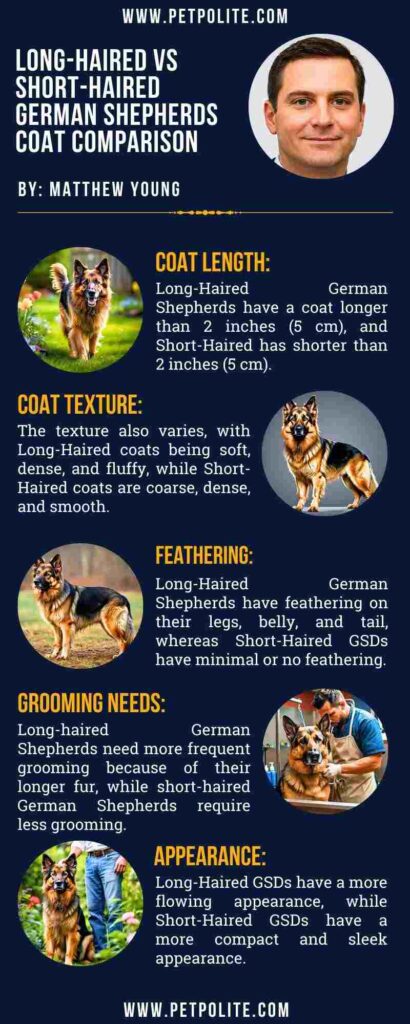
Following are some key differences between their coats:
1. Long-Haired German Shepherds:
Long-haired German Shepherd has a beautiful, flowing coat that gives them a majestic appearance. They have softer and denser fur which provides extra protection against harsh weather.
This fur is longer than short-haired German Shepherds, and have more feathering (long, flowing hair) around the ears, chest, legs, and tail.
This longer, flowing fur gives them a more luxurious and striking look.
However, this luxurious coat requires more frequent grooming to prevent matting and tangles. You’ll need to invest more time in regular brushing to keep their coat at its best.

“Long-haired German Shepherds look like classic German Shepherds but have long, shiny coats. They have extra fluffy ears and bushy tails. Their chest hair is longer, like a ruff or a lion’s mane.”
Source: DogAcademy.Org
2. Short-Haired German Shepherds:
In contrast, a short-haired German Shepherd has a more practical and low-maintenance coat.
Their fur is dense and close to the body, making it easier to groom and less prone to matting. This type is often referred to as the stock coat.
It offers excellent protection against dirt and debris, making it ideal for active lifestyles.
Short-haired German Shepherds require less frequent grooming, saving you time and effort.
Long-Haired vs. Short-Haired German Shepherd Shedding Patterns
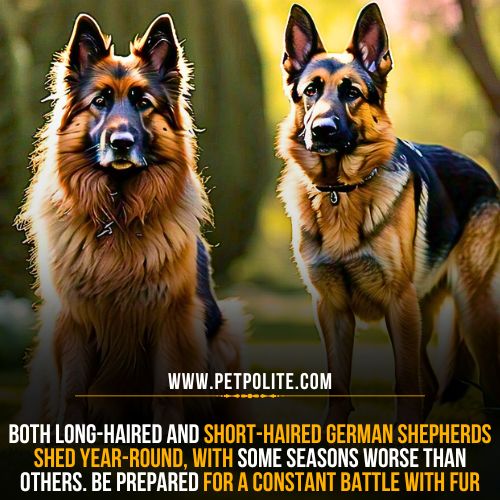

1. Year-Round Shedding:
Both long-haired and short-haired German Shepherds shed consistently throughout the year due to the natural hair growth cycle.
Long-haired German Shepherds have a luxurious, flowing coat that sheds old or damaged hair daily, leading to strands of fur around your home, on your clothes, and in unexpected places.
Short-haired German Shepherds, with their sleek, close-lying fur, also follow the same hair growth cycle, which cause daily shedding.
Their short, coarse hairs can be more challenging to clean up as they tend to embed into fabrics and carpets.




“German Shepherds are known to shed their coats constantly throughout the year, therefore, they are called “German Shedders” due to their heavy shedding tendency.”
Source: K9Dryers.Com
2. Seasonal Shedding:
In addition to year-round shedding, both long-haired and short-haired German Shepherds experience significant seasonal shedding, often referred to as “blowing coat.”
This occurs twice a year—in the spring and fall. During these periods, they shed their undercoat heavily to adapt to changing temperatures.
In spring, they lose their thick winter coat to prepare for warmer weather, and in fall, they shed their lighter summer coat to make way for a denser winter coat.
Here is a video of a 2-year-old German Shepherd named Logan, who is shedding his undercoat after the winter season.
For long-haired German Shepherds, this results in large clumps of fur coming loose, creating more mess than usual.
While short-haired German Shepherds shed their fine hairs in smaller, more scattered amounts, which can actually create more mess due to their tendency to spread and stick to surfaces.
Shedding Differences Between Long-Haired & Short-Haired German Shepherds
As long-haired and short-haired German Shepherds follow almost same shedding patterns, but their are some differences in their shedding habits.
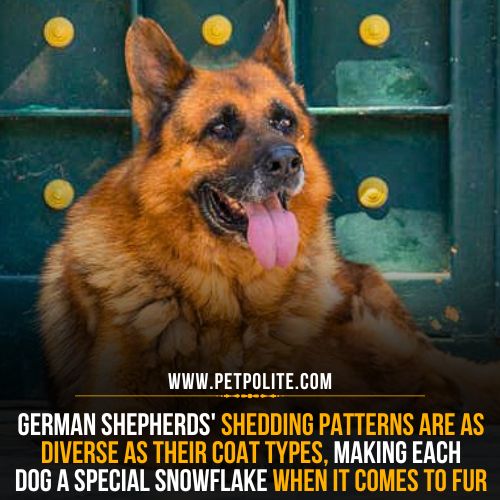

Here are some of those shedding differences:
1. Shedding Frequency:
When you compare long-haired and short-haired German Shepherds, you’ll notice they shed differently.
Long-haired German Shepherds shed less often but do it steadily all year.
Short-haired German Shepherds, however, have a more noticeable shedding pattern and shed consistently.
They shed a lot during spring and fall when they lose their old fur.
2. Amount of Fur:
At first, the amount of fur shed by long-haired German Shepherds can seem like a lot.
Their long fur tends to come out in big clumps, which makes it more noticeable around the house. In contrast, short-haired German Shepherds shed smaller, finer hairs.
Individually, these hairs might not seem like much, but they can quickly pile up and become just as problematic if not cleaned up regularly.
3. Grooming Requirements:
Long-haired German Shepherds need to be brushed more often to prevent their fur from matting and tangling.
It helps remove loose hairs before they end up on your furniture and floors.




“Long-haired German Shepherds are more likely to get tangled and matted fur, so they need to be brushed and groomed more often to prevent this.”
Source: AnimalHearted.Com
For short-haired German Shepherds, you still need to brush them, but not as often.
Their shorter coats are less likely to mat, so brushing 3-4 times a week is usually enough to keep shedding under control.
4. Cleaning Challenges:
The type of fur your German Shepherd has affects how you clean your home.
Long-haired German Shepherds leave bigger clumps of fur that are easier to see and pick up, but they can get stuck in carpets and furniture.
Short-haired German Shepherds shed fine hairs that can embed deeply into fabrics, making them harder to remove.
You’ll need a good vacuum cleaner with strong suction and a pet hair attachment to clean up after a short-haired German Shepherd effectively.
5. Allergy Considerations:
If someone in your home has allergies, the type of German Shepherd you have can make a difference.
Long-haired German Shepherds shed less often, but they lose more fur at once, which can trigger allergies.
Short-haired German Shepherds might be worse for allergies because they shed heavily twice a year, releasing more dog dander into the air during these times.
Do Long-Haired German Shepherds Seem To Shed More Than Short-Haired?
It might seem like long-haired German Shepherds shed more than their short-haired fellows.
When you see those beautiful, flowing coats, it’s easy to imagine they would leave behind more fur.
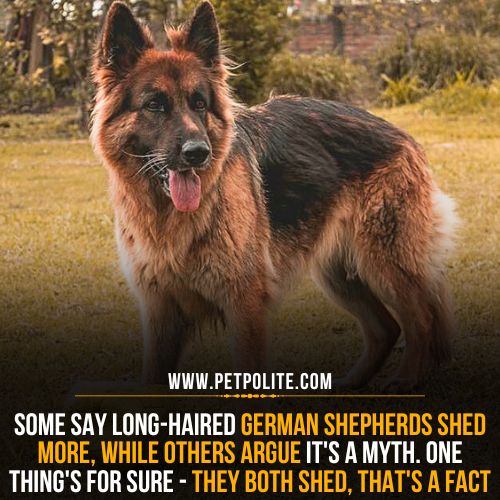

Let’s discuss why it might look this way and uncover the reality of their shedding patterns.
1. Why It Seems Long-Haired German Shepherds Shed More?
When you look at a long-haired German Shepherd, the sheer volume of their coat can be deceiving.
Long fur is more noticeable on your furniture, clothes, and floors. Every time your dog shakes or runs, the longer hairs are more likely to get caught in the air, landing visibly on surfaces.
This can give the impression that they are shedding more than short-haired German Shepherds.
Another reason is the clumping factor. Long fur tends to form more noticeable clumps.
You might find tufts of hair around your home, which can make it seem like there’s an endless amount of shedding going on.
Short hair falls out too, but it’s thinner and harder to see, so it blends in and doesn’t show up as much.
Here’s a table to summarize why long-haired German Shepherds seem to shed more:
| Reason | Description |
|---|---|
| Longer Fur | Longer hair is more noticeable and sticks to surfaces, making shedding look worse than it is. |
| Volume of Coat | The large amount of fur can make it seem like they shed more than they do. |
| Fur Gets Caught in Air | Longer hair gets caught in the air and lands on surfaces, making shedding seem heavier. |
| Matting and Tangling | Long hair mats and tangles, and cause large clumps to come loose and appear excessive. |
| Visibility | Long hair stands out more, making every loose hair visible, unlike shorter hair that might be missed. |
2. Which Sheds More Long Hair Or Short Hair German Shepherd?


The truth is, both long-haired and short-haired German Shepherds shed quite a bit. In fact all types of German Shepherds shed.
They shed because of their undercoat is adapting to different weather conditions during spring and fall. During this time, they shed heavily to shed their undercoat. Rest of the year, they shed moderately.
As for long-haired German Shepherds, they do not shed more than short-haired ones. The amount of shedding is generally the same, but the visibility and manageability differ.
Long fur is more noticeable and can seem like more, but short fur can spread out more evenly, creating a different kind of mess.
How Much Shedding Is Normal For Long-Haired German Shepherds?
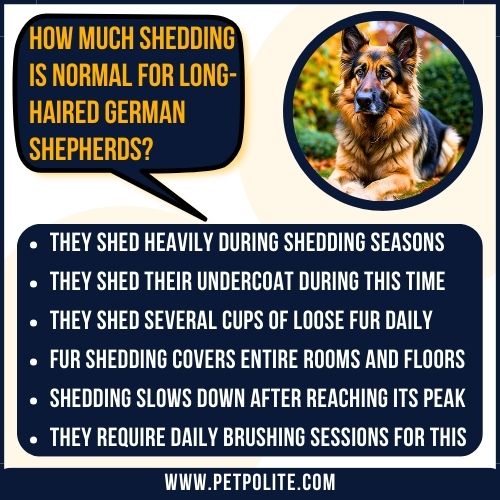

A certain amount of shedding is completely normal for long-haired German Shepherds.
They shed heavily during shedding season (spring and fall), and moderately during the rest of the year.
On a daily basis, you’ll notice loose hair everywhere – on your furniture, clothes, and floors.
To prevent matting and tangling, you’ll need to brush your dog 3-4 times a day and more often during shedding seasons.
You’ll also need to schedule regular grooming sessions every 4-6 weeks to keep their coat under control.
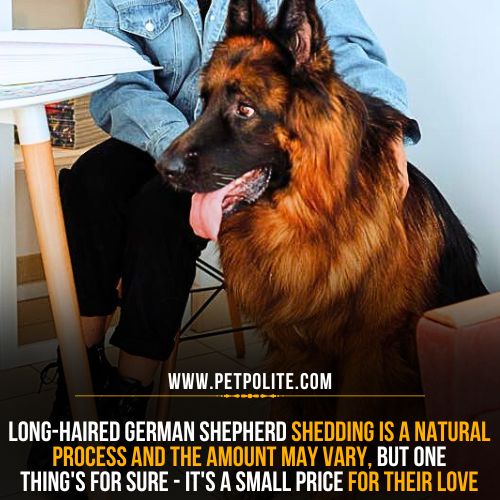

While it may seem like a lot of work, remember that this is a normal shedding pattern for these dogs and as a responsible owner, you should prepare yourself for this struggle.
But if your German Shepherd is shedding excessively outside of the usual shedding seasons, or if their coat looks patchy or unhealthy, it could be a sign of a health issue.
In such cases, it’s best to consult your veterinarian to rule out any underlying problems.
Conclusion:
Long-haired German Shepherd shedding can be more significant and noticeable than short-haired. The length and density of their fur contribute to the perception of increased shedding.
The truth is, that both long-haired and short-haired German Shepherds shed quite a bit due to their double coats.
While the shedding amount is generally the same, the visibility and manageability differ.
Long-haired German Shepherd shedding can seem more noticeable because of the length of the fur, while short-haired German Shepherd fur spreads out more evenly.
Therefore, you need to be aware of these differences to manage shedding and maintain a clean environment for both types of German Shepherds.
Frequently Asked Questions:
Is it OK to trim a long-haired German Shepherd?
Yes, it’s okay to trim a long-haired German Shepherd’s fur for hygiene and maintenance, but avoid shaving as it can harm their coat and skin.
Do long-coat German Shepherds need haircuts?
Long-coat German Shepherds don’t need haircuts but regular trims, especially around the ears, paws, and hindquarters, to keep them clean and tangle-free.
Do long hair German Shepherds shed badly?
Yes, long-haired German Shepherds shed heavily year-round, with more intense shedding during seasonal changes.
Which type of German Shepherd sheds the least?
All German Shepherds shed but short-haired or stock coat types generally shed less than long-haired varieties.
Are long-haired German Shepherds hypoallergenic?
No, long-haired German Shepherds are not hypoallergenic. They shed heavily and produce dander, which can trigger allergies.
Do long coats shed less than stock coats?
No, long coats typically shed more than stock coats due to their dense undercoat and longer fur.
How bad do short-haired German Shepherds shed?
Short-haired German Shepherds shed moderately year-round and heavily during shedding seasons, but less than their long-haired companions.
Can I shave my long-haired German Shepherd?
it’s not recommended to shave your long-haired German Shepherd as it can cause sunburn, skin irritation, and damage to their coat’s natural protection.
Resources Used For Research:
- Understanding the Genetics of Dog Shedding – Hollywood Feed Education
- Genes affecting coat colour and pattern in domestic dogs: a review – Wiley Online Library
- Does hair coat length affect flea infestation in naturally infested dogs? – Scielo Brazil
- Shedding Plus – Veterinary Genetics Laboratory by UCDAVIS Veterinary Medicine
- German Shepherds: A Practical Guide for Owners and Breeders – A Book by Allison Clarke and Lizzy Brown
